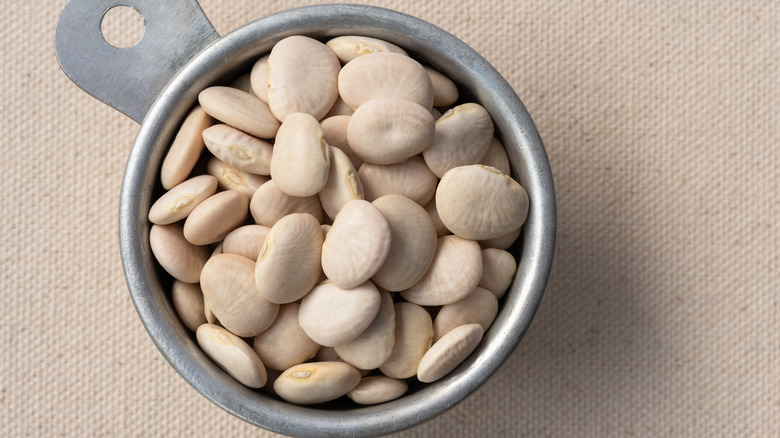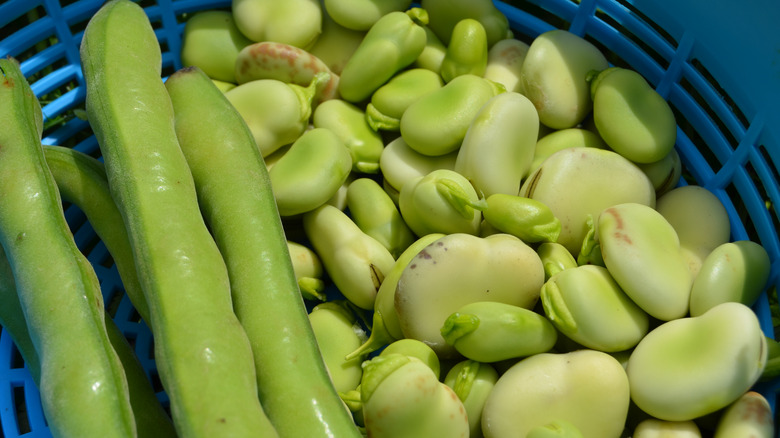The Unique Bean That Has More Potassium Than A Banana
When it comes to the nutritional value of a banana, this bright yellow fruit has us going, well, bananas. Wrapped up inside the peel of one medium-sized raw banana is 3.07 grams of fiber, nearly 6 milligrams of calcium, 10.3 milligrams of vitamin C, and much more, according to the U.S. Department of Agriculture (USDA). Along with zinc, magnesium, niacin, manganese, and numerous other nutrients, potassium content is where bananas really shine.
With 422 milligrams of potassium, it's no wonder that bananas are purported to support cardiovascular health, regulate blood pressure, maintain kidney health, and aid in muscle recovery following physical activity (via Healthline). While it's easy to assume that you can't do much better than a banana when it comes to potassium, it turns out that maybe you can. However, you'll have to veer away from the fresh fruit section of your grocery store to find this mystery food item. What are we looking for exactly? Lima beans.
1 cup of lima beans versus 1 cup of bananas
Yes, you read that right. In 1 cup of cooked, salt-free lima beans you'll find 955 milligrams of potassium — more than double what you would get from a medium-sized banana (via USDA). Also rich in fiber, calcium, phosphorus, magnesium, and more, lima beans may help reduce one's likelihood for acid reflux, manage cholesterol and blood sugar levels, and minimize heart disease risk (via StyleCraze).
If you're still not convinced, let's take some more precise measurements. When comparing the 955 milligrams of potassium found in 1 cup of cooked lima beans void of salt, these legumes still outrank 1 cup of sliced raw bananas, which contains 537 milligrams of potassium (per USDA). This remains true even if you compare that same serving of lima beans to 1 cup of raw mashed bananas, which has 806 milligrams of potassium. Lima beans' potassium content further skyrockets to 3,060 milligrams in 1 cup of raw lima beans with mature seeds (via USDA). But don't go chowing down on a whole bunch of raw lima beans now. Doing so can have some potentially serious health consequences.
Lima bean risks to be aware of
When ingesting raw lima beans, a compound known as linamarin gets broken down into hydrogen cyanide, reports Huff Post. If eaten in excess, such cyanide exposure can be fatal. However, the odds of cyanide poisoning from eating raw lima beans are slim, as cyanide-containing plants consumed in the U.S. have low levels of the chemical (via Agency for Toxic Substances and Disease Registry). Not only that, cooking lima beans for 10 minutes or more eliminates this risk.
Even when cooked, however, lima beans can have some drawbacks. For one, lima beans can prompt allergic reactions in some individuals (via StyleCraze). Additionally, eating large amounts of cooked lima beans can be a recipe for tummy trouble. This may include cramping, gas, diarrhea, and more. Finally, those with certain health conditions, such as anemia or certain nutrient deficiencies, will want to first speak to their doctor before incorporating cooked lima beans into their diet. The reason is that lima beans also contain some anti-nutrients, which may prevent the body from absorbing all of the nutrients it needs.



